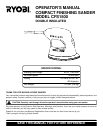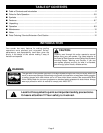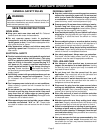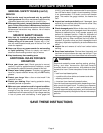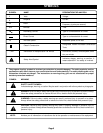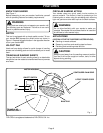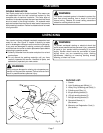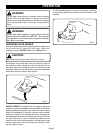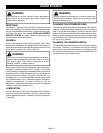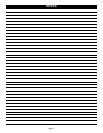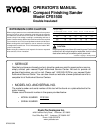
Page 8
When correctly positioned, the outer edges of the sanding
sheet or scrubbing pad will line up with outer edges of the
base pad.
To replace sanding sheets or scrubbing pads, simply pull
the old sheet or pad off the base pad and attach a new one
as described above.
ROTATING THE SANDING SHEETS
The majority of wear in a precision sanding application occurs
at the tip of the sanding sheet. The unique design of the
sanding sheets and scrubbing pads allows you to detach
and rotate the top two thirds of each and extend the life of
the pad or sheet.
To rotate the top of the pad or sheet, simply remove the top
two thirds along the perforation. Rotate the pad or sheet so
that a clean corner is located at the tip of the base pad.
See Figure 4.
Press the pad or sheet firmly onto the base
pad.
WARNING:
Failure to unplug your sander could result in accidental
starting causing possible serious personal injury.
SELECT THE PROPER SANDING SHEET/
SCRUBBING PAD
Selecting the correct size grit and type sanding sheet is an
extremely important step in achieving a high quality sanded
finish. Aluminum oxide, silicon carbide, and other synthetic
abrasives are best for power sanding. Natural abrasives,
such as flint and garnet are too soft for economical use in
power sanding.
In general, coarse grit will remove the most material and
finer grit will produce the best finish in all sanding operations.
The condition of the surface to be sanded will determine
which grit will do the job. If the surface is rough, start with a
coarse grit and sand until the surface is uniform. Medium
grit may then be used to remove scratches left by the coarser
grit and finer grit used for finishing of the surface. Always
continue sanding with each grit until surface is uniform.
Sheet/Pad Recommended Use
Red scrubbing pad Paint and rust removal
White scrubbing pad Light scrubbing and cleaning
Polishing pad Polishing finished surfaces
60-grit sanding sheet Coarse sanding
120-grit sanding sheet Light sanding
240-grit sanding sheet Finish sanding
WARNING:
Your sander should never be connected to power supply
when you are making adjustments, installing or replacing
sanding sheets or pads, cleaning, or when not in use.
Disconnecting your sander will prevent accidental starting
that could cause serious personal injury.
WARNING:
Never use your sander for wet sanding or liquid polishing.
Failure to comply can result in electrical shock and
possible serious injury.
OPERATION
ATTACH SANDING SHEET/SCRUBBING PAD
Align the bottom of the sanding sheet or scrubbing pad with
the bottom base of your sander. Working your way up to the
tip of the base, press the sheet firmly onto the base pad.
See Figure 3.
Fig. 3
Fig. 4



